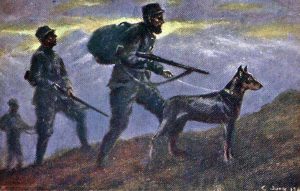Prepare to be amazed by the scouts, sentries, ambulance and messenger dogs of WW1. During the Great War the military dogs first trained by military Scotsman Lt Col Edwin Hautenville Richardson proved invaluable as trench dogs. Other dogs of smaller size, did an amazing job as ratters.
Dogs used as scouts during WW1
These dogs were trained to point when an intruder was spotted (sniffed) and not bark since secrecy was the key to these missions. They could detect enemy scent up to 1000 yards away.
Scout dogs were trained to stiffen, raise their hackles and point their ail, thus indicated that an enemy was approaching.
Germans were the first to use scout dogs, sending them over no man’s land to spy on Allies’ positions.

Dogs used as sentries or guards
These dogs were invaluable especially during the night when they would prevent any night surprises coming from the enemy.
Either in the front lines, to guard against enemy incursions, or guarding important facilities or locations behind the lines together with their handler, dogs proved priceless.

They were trained to give a warning signal such as a growl, or snarl to indicate a suspect presence.
Sometimes dogs even worked alone in a trench, especially at night, to watch out for enemy activity while the humans rested.
Messenger dogs of WW1
Give their small size and speed, dogs soon proved to be much better at delivering messages than any human, especially when any other mean of communication was cut off or the battle was taking place in an inhospitable land, such as the jungles of Pacific Islands.

Dogs also braved the bullets, showing much determination in getting the job done.

The dogs were trained to ignore the fire of guns of all calibers, and were accustomed to the explosion of hand grenades near them.

Sometimes messenger dogs carried… other messengers.

Other dogs were trained as Ambulance or Casualty Dogs, Red Cross Dogs or Mercy Dogs
Although still informal, dogs helped a great deal during the Great War. It is believed that on both sides 10 000 dogs served in the Red Cross and these dogs undertook the most severe training.

One of my favorite pictures from the Great War depicts two canine buddies walking side by side, two Red Cross dogs.

Were they a team? One carrying medical supplies, the other one, with a gas mask on, trained to jump in the trenches, checking for the wounded soldiers? Were they taking strength from each other? Their body language tells me they were happy, determined on their task.
Germans were the first to begin training Ambulance Dogs, Sanitatshunde, in 1893.

“First Aid Dogs” were trained not to bark when they found a disabled soldier and to disregard dead soldiers. On locating a wounded soldier, the dog was trained to get close enough so that the soldier may open the first aid box the dog carried. Then the canine would tear a piece of the uniform or retrieve the soldier’s cap back to the kennel – to identify the fallen soldier.

Returned to the kennel the dog would bark and head back, showing he found an injured soldier.
Of course, this was in theory and real life situations forced a change in the way the Red Cross Dogs were trained as sometimes there was no cap and the loosest thing a dog chose to remove was often a bandage. Eventually dogs were fitted with a loose collar which they could grab and hold in their mouth as a sign they found a wounded soldier.
In the aftermath of a battle, the Red Cross dogs would localize the wounded and wait by their side for the stretcher bearers to arrive and pick up the soldier, transporting him to a hospital.

What is amazing is that dogs were indeed trained to recognize uniforms in order to tell friend from foe.

England, France, Russia and Germany – they all used military dogs trained for the the same purposes. And, true to their nature, the dogs often did more than it was expected from them.
Although some dogs were trained as messengers, when a buddy was in need they didn’t shied away from the task.
Prusco, a French dog that looked like a white wolf, is said to have saved more than a hundred men. On another occasion he dragged three wounded soldiers to a safe place, out of enemy fire, where they could wait to be removed from the battlefield.

Italians trained some of their dogs to carry ammunition over hard to reach mountain passes by means of a harness and strapped to their backs.

In France, WW1 saw the boom of the “Societe Nationale des Chiens Sanitaires” in France.

Of course, war propaganda was quick on picking up the civilian’s interest in war dogs, these silent heroes, and use it as this French postcards shows. This postcard (bellow) was banned in 1915 because censors felt its cruel spirit was demeaning to France.

So far we saw how the friendship between humans and dog started, some 26 000 years ago. we saw how dogs joined kings in battles and why dogs are so indispensable during war. We saw how canines helped in the trenches as scouts, sentries, ambulance and messenger dogs. Next time we will look at dogs who pulled machine guns and sleigh and then at some mascot dogs of WW1 and WW2 as well as how the role dogs plaid during the Second World War changed. And we won’t stop there, so be sure to return and check new blog posts.
Do check out my book Joyful Trouble, A humorous read about an incredible dog and how he had found his true, yet unexpected calling. It is a book for all ages.

My adult fiction book, Silent Heroes, is a #1 New Release, a contemporary fiction novel, filled with action and emotional twists and turns. “Silent Heroes” has a strong historical and cultural feel of the area when the action takes place, Afghanistan.


